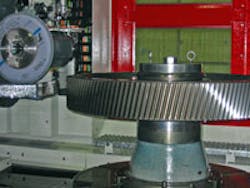What Does It Take to Produce Gears for Wind Turbine Manufacturers?
Gear grinding using special fixturing to support the weight and torque
Q: What are the challenges when machining gears for wind turbines?
Gears for wind turbine applications are typically large in diameter and have wide face widths, requiring very exacting material composition and heat treatment processing. The gear design must be optimized to ensure low rolling resistance and long life, owing to the extreme costs of maintenance, down time, and repair of the gear box assemblies once they have been commissioned in the field.
Every step in the manufacturing phase of these gears must be carefully processed, documented, and controlled to achieve the high quality, consistency, accuracy, and reliability that is demanded for operation in these environments.
The use of carburized steel for these gears is common and the associated heat treatments and stress-relief operations have to be exacting to minimize part distortion and growth, as well as to achieve the proper metallurgical properties required. Oftentimes, a preheat treatment of the forging or bar stock is necessitated on these large gears to minimize part distortion. In addition, one of the seemingly small but critical techniques to minimize distortion on gears is the vertical insertion of the gear into the quench tank during the hardening phase.
Heat treatment can cause cracks as well, so careful processing with predetermination of stock allowance for grinding and final case depth must be considered. Inspection for cracks with magnetic particle inspection and for grinding burns utilizing nital etching is an important inspection tool.
Finally, off center crown grinding of the tooth geometry may be needed to properly distribute the load on the gear teeth.
What modifications, if any, are needed to the tooling or the machine tool, to make gears for this market segment?
Rigid, heavy-duty hobbing machines are needed for the coarse pitch gears, using roughing hobs or gear milling (gashing) cutters.
Likewise, coarse pitch diamond dressing rolls and special grinding wheel abrasives are required for the large, high-accuracy gear grinders to produce efficient, accurate results and to prevent grinding burns and cracks.
The cutting fluids we use must have the proper viscosity, the right amount of extreme pressure additives, and must be directed to the exact location of the work piece and cutting tool interface to maximize results. These fluids have to be routinely sampled and adjusted for optimum results.
Likewise, in the process of building the gearbox, what special considerations must be taken into account?
Establishing the correct bearing clearances/preloads is critical to long life and proper gearbox operating temperature. Sophisticated measuring techniques with bearing inspection gages can only insure these results. The type and method of lubrication and proper sealing weighs heavily on the performance of a gearbox. The verification of gearbox performance through computerized analysis and testing is a crucial step to insuring long life.
What are some of the ancillary requirements in gear preparation for wind turbine applications?
Special work holding and fixturing is an obvious consideration to bear the weight and to reduce the vibration and movement of the gear blank while hobbing or roughing. Careful and uniform torquing of the clamping fasteners during these operations prevents workpiece movement and distortion of the gear blank during the roughing operation. The gear blank must have accurate mounting and indicating surfaces to control the pitch line runout to critical features (bearing journals, splines, etc.), and to minimize lead error.
The critical factor here — as with all similar power transmission applications — is that the gears are properly designed and manufactured. The other mechanical components that make up the assembly, along with the gearing, must be applied/designed so the overall system performance does not have any shortcomings that could affect the performance and life of the unit. Then if the sub-assembly/assembly is carried out with real precision and care, a favorable outcome is sure to follow.
N.K. Chinnusamy is the president of Excel Gear Inc., a “total service company” that specializes in design, manufacturing and analysis of coaxial gearboxes, custom built gears, helical/bevel gearboxes, internal gears, spur gears, worm gears, gear-driven high-speed machine spindles, CNC gimbal heads and wind turbine gearbox components. It performs full FEA and vibration analysis, plus complete metallurgical and heat treatment evaluation.
